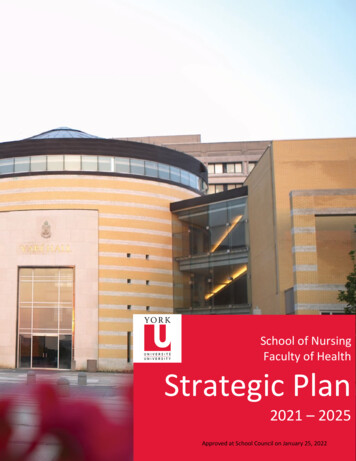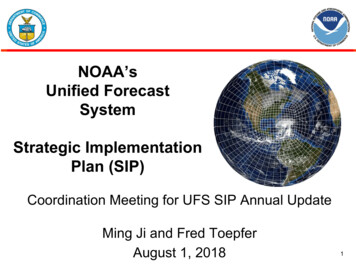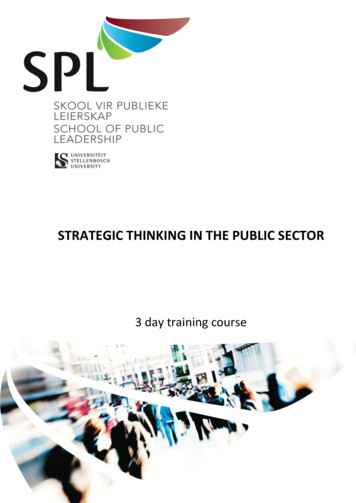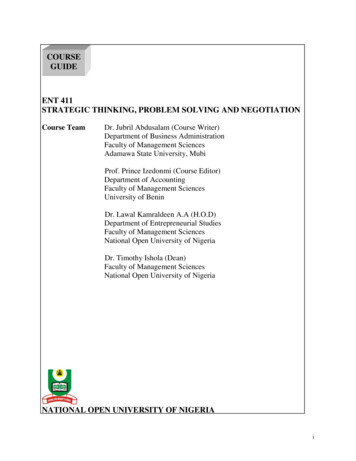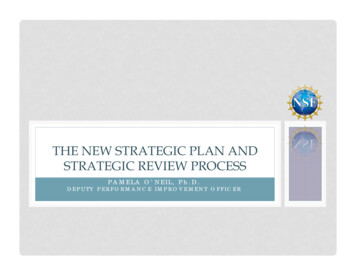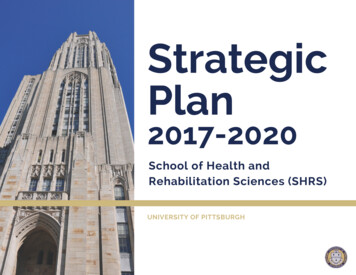
Transcription
StrategicPlan2017-2020School of Health andRehabilitation Sciences (SHRS)UNIVERSITY OF PITTSBURGH
Message from the DeanPeople with serious injuries or chronic disabling conditions are among the most challenging with respect to cost of care and access to care and services. The School of Health andRehabilitation Sciences (SHRS) is dedicated to: (1) primary, secondary and tertiary prevention* of injury and disability through health promotion and wellness initiatives that are tailored tosusceptible populations and (2) treating, rehabilitating and advocating for the growing number of people living with disabling conditions. As such, we focus much of our academic andresearch attention on uncovering best practices and optimal solutions to quality of life concerns related to activity and participation, function, mobility and independence. SHRS strives to doits part contributing to health care reform’s triple aim of improving patient care, improving the health and well-being of all populations and reducing/controlling costs. We must redefine theroles of the professions represented within the SHRS in the context of a fundamental focus on value, quality and cost-effective initiatives, many of which are already being implemented. Ashealth care systems move from a fee-for-service payment structure to models factoring in quality and patient satisfaction as a determinant of reimbursement, SHRS must respond by:Raising performance expectations of our students and new graduates to include:reduced variability through more consistent delivery of evidence-based practice as part of an inter-professional teamelevated involvement in health management for people with severe injuries or disabling conditions, as well as people who are atrisk for disease, injury or disabilityengagement in community education, prevention and wellness services to affect the health and well-being of all peopleadvocacy for and design of models of care by which the professionals will be an integral part of the primary care model in affectingindividual and population healthExpanding our research portfolio to include investigations that address human optimization, movement systems optimization andcutting-edge rehabilitation and disability-related concerns as we further demonstrate the value of the health professions represented inSHRSForging new partnerships with resource-rich academic and medical/health centers as we deliver professional preventive andtherapeutic services and employ advances in technology across the continuum of care and measure their cost-effectiveness.The SHRS Leadership Team is performing under a renewed sense of urgency as we evaluate our expanding role in global health,wellness, rehabilitation and disabilities, and determine the optimal path to educate and train eager and determined scholars andresearchers. In this period of rapid transformation of our health care system and the promise of improved access across the board,tremendous opportunities await as we: (1) discover ways to utilize the professions represented within SHRS to expand affordable accessto health care for all people, (2) demonstrate the value of health professions through prevention services and care delivery across thehealth care continuum, (3) continue to pioneer advances in assistive technology to promote affordable full participation for people with orat risk for serious injuries and disabling conditions, and (4) refine our interventions with the goal of optimizing human performance forpeople across the spectrum of functional abilities and participation in life roles.*[Commission on Chronic Illness (1957), Institute of Medicine (1994, 2003)]Dean Anthony DelittoPrimary Prevention: Reduce incidence of a disorder or disability (occurrence of new cases).Universal Prevention: Prevent or delay onset new cases in the entire population by providing information and skills regardless of potential risk.Selected Prevention: Prevent or delay onset of new cases to segments of the population at risk by virtue of broadly defined characteristics.Indicated Prevention: Prevent or delay progression of new cases in individuals exhibiting early signs of chronic illness.Secondary Prevention: Reduce prevalence of a disorder or disability (all existing cases).Tertiary Prevention: Reduce sequelae and complications arising from the disorder or disability once it is manifested.2
Brief History of SHRSEstablished in 1969 and representing the youngest of the six health science schools, the "School ofHealth Related Professions" (SHRP) initially focused on educating entry-level practitioners in a varietyof health related professions and preparing established clinicians to assume leadership roles in theregion, state and country. The 1990s began an extraordinary period of expansion and transformation inthe School beginning with a name change from SHRP to the "School of Health and RehabilitationSciences" (SHRS). We were one of the first schools of its kind to introduce the term "rehabilitationscience" which not only represents the rehabilitation fields but, more importantly, precisely capturesthe body of science that encompasses the breadth of research within SHRS. In addition to expandingthe number of degree offerings, the period of 1992 – present saw unprecedented growth in SHRSscholarly productivity.Presently, SHRS’s educational offerings are comprised of rehabilitation fields (assistive andrehabilitation technology, audiology, speech-language pathology, occupational therapy, physicaltherapy, prosthetics and orthotics, rehabilitation counseling, rehabilitation science and technology) andhealth care related fields (physician assistant studies, emergency medicine, health informationmanagement, sports medicine/athletic training and nutrition).Four SHRS graduate programs earned top-10 spots in the most recent "U.S. News and World Report's"graduate school ranking of disciplines (Physical Therapy #1; Occupational Therapy #4; SpeechLanguage Pathology #7 and Audiology #7) and are the most highly rated in their respective disciplinesamong colleges and universities of the Commonwealth of Pennsylvania. Present research budgets inexcess of 21 million in fiscal year 2017 span the translational spectrum from basic to applied sciences.Throughout, SHRS has promoted its mission in the context of full participation of persons withdisabilities.3
SHRS Vision, Mission and ValuesEstablished in 1969 as a health sciences school of the University of Pittsburgh, SHRS stands on its solid reputation as an international leader inrehabilitation and disabilities education, research and community service, improving the lives and independence of all people with a focus on people atrisk for or having chronic conditions or disabilities and those who have traditionally been underserved and underrepresented.Our VisionTo be a catalyst for a world free of barriers anddisparities that allows all people, regardless ofhealth, to have opportunities to participate inlife to the fullest; to be accomplished througheducation, research and service.Our MissionOur ValuesTo advance health, rehabilitation andreintegration service delivery through teaching,research and professional service.Advocacy – for those less fortunate or withlimited access seeking greaterindependenceExcellence – in all endeavors and facets ofour workInclusion – in student enrollment and facultyand staff composition with a major focus oninclusion of people with disabilitiesInnovation – in teaching and educationalcurricula, research, technology, and productdevelopmentIntegrity – through uncompromisingadherence to ethical principles, truthfulness,dignity and respect in all that we doService – to all, including the disabilitiescommunity, in regard to rehabilitation andhealth services with a commitment to socialresponsibilityWe advance our Mission and pursue ourVision by:Providing an unparalleled environment foreducation and trainingSupporting an inter-professional approachto research to address challenges of peoplewith acute and chronic conditions anddisabilitiesCollaborating with local, national andinternational partners to address andimprove integration of rehabilitation servicesin health care delivery systems, communityengagement and models of care.4
University Goal #1:Advance Educational ExcellenceWe aspire to be a university that prepares students to lead lives of impact througha supportive environment focused on a holistic and individualized approach tolearning inside and outside the classroom.Physical Therapy Boot Camp
University Goal #1: Advance Educational ExcellenceEnhance the curriculum at all levels through innovative, discipline-based approaches to teaching and learning andappropriate uses of technology to enrich the on-campus learning environment.SHRS Initiatives:1. Improve the efficiency of course delivery in an interdisciplinary manner that would capitalize on the considerable expertise within our programs.EXAMPLE: Using technology and innovation to deliver common foundational sciences (e.g. anatomy, neuroscience, physiology) in a structured andprogressive manner that provides breadth and depth while minimizing redundancy.2. Create inter-professional opportunities internal and external to SHRS, including the expansion of patient/client simulation cases incorporating interprofessional interaction and the development of real-life inter-professional delivery models (e.g., Falk Trauma Clinic, Birmingham Clinic andCommunity Engagement Center).3. Collaborate with partners (e.g. UPMC, UPMC Health Plan, local businesses, University) to develop wellness programs centered in non-medicalenvironments where inter-professional care can be delivered by multi-disciplinary students and professionals where “top-of-license” caregiving is rolemodeled and practiced.4. Innovate SHRS student/faculty inter-professional clinics to prepare students to practice “at the top of their license(s)” that does not compete with ourclinical partners.5. Analyze the feasibility of distance education models for SHRS professional programs including delivery of plans of study to the regional campuses.6. Develop and provide inter-professional and post-graduate continuing education programs.7. Explore new and innovative program offerings through partnership with community stakeholders that are consistent with health care reform.8. Expand and enhance program offerings necessary to maintain professional expectations (e.g., Doctor of Occupational Therapy entry-level professionaldegree program).9. Continue to develop partnerships with UPMC and non-UPMC affiliated health care systems to expand clinical education offerings for all programs.10. Maintain excellence with all accreditation reviews.Serve as a leader in personalizing educational experiences of undergraduate, graduate and professional students, withparticular attention to mentorship, advising, and tailoring engagement to the goals of individual student.SHRS Initiatives:1. Engage students in personalized professional development opportunities and mentoring relationships.2. Personalize courses and/or curriculum to maximize educational choices/match educational experience with student interests and goals.3. Support and advocate for individualized clinical experiences for undergraduate and graduate-level students based on their interests(internships, fieldwork, supervised practice, student research collaborations/laboratory exchanges at other institutions, etc.).4. Engage in stronger, more productive collaborations with public and private partners in regional, national, and international communities to enhanceopportunities for enriched education and training.5. Evaluate opportunities to include service learning in health and wellness initiatives through inter-professional experiences.6. Engage PhD students in personalizing their experience through the milestones and achievements survey process established by SHRS.7. Consider adopting a publication requirement for doctoral (PhD) students as a condition of graduation.6
University Goal #1: Advance Educational Excellence, cont.Enrich the student experience through engagement with diverse cultures and perspectives and expanded opportunities forstudy abroad and by integrating global perspectives in the curriculum.SHRS Initiatives1. Expand upon existing study abroad opportunities for students within all SHRS programs.2. Establish graduate student research collaborations/laboratory exchanges at foreign institutions.3. In concert with community partners, design, develop and implement inter-professional service learning opportunities to Increase cultural awareness offaculty, staff and students of diverse populations including LGBTQA community, people with disabilities, populations with diverse cultural/linguisticbackgrounds.Promote access and affordability through partnerships with local school districts, increased voluntary support for student aid,improved time-to-degree for all students, and expanded access to masters and professional education.SHRS Initiatives1. Explore means to reduce the tuition burden and/or time-to-degree for SHRS undergraduate, entry-level professional and graduate students whilemaintaining the quality and integrity of the program(s) and meeting/exceeding accreditation requirements.2. Continue to identify, qualify, cultivate and steward sources of support for need and merit-based scholarships.3. Develop an SHRS Doctoral Scholarship program to support dissertation research.4. Examine the feasibility of reducing time-to-degree for the undergraduate Rehabilitation Science program.7
University Goal #2:Engage in Research of ImpactWe aspire to be a university that advances the frontiers of knowledge and makes apositive impact on the world through collaborative and multidisciplinaryapproaches to research that focus on areas of great societal need.Human Engineering Research Laboratories (HERL)
University Goal #2: Engage in Research of ImpactIdentify and engage in strategic research opportunities where we can have significant impact on society.SHRS Initiatives1. Collaborate with the CTSI, Health Policy Institute and other University organizations to engage in:a. health services research to explore comparative effectiveness research in high impact conditions where there is documented waste and suboptimaloutcomes.b. quality of life optimization research in the areas of mobility and activity, prevention and management of chronic conditions, functional cognition andcommunication, community wellness and independent living, and assistive and rehabilitation technology development and utilization.2. Engage in dissemination and implementation (D&I) research to study the effectiveness of executing the innovative research results obtained acrossSHRS.3. Expand SHRS Implementation Science efforts into an operating unit (Department, Center or Institute) where innovations can be implemented ineveryday care and evaluated for cost-effectiveness; barriers to execution can be identified; and strategies formulated to eliminate barriers.Position the University to participate in large research collaborations through investments in shared core facilities; strategicrecruitment; and partnerships with industry.SHRS Initiatives1. Capitalize on our partners’ already-existing research infrastructure to create a data network capable of managing large data sets from existing data orprospective trials focused on prevention and management of chronic conditions as well as efficiency and effectiveness of care.2. Develop new collaborative networks and partnerships with industry to support the development and implementation of mobile health and telehealthtechnologies to optimize personalized health management for individuals with or at risk for chronic conditions.3. Strengthen and advance collaborative networks and data sharing to support widespread implementation of effective wellness and rehabilitationinterventions in health systems and community-based settings.4. Develop a repository for shared resources in performance optimization and movement science in populations with or at risk for impairment or disability.Expand our computational capacity, human and physical, to meet research needs across a broad range of disciplines into thefuture.SHRS Initiatives1. Continue to invest in and utilize all appropriate computational resource facilities across the University.2. Foster big data research collaborations to track and understand human activities and behaviors that may be used to personalize movement-basedrehabilitation and optimization, to prevent and manage chronic conditions, and to improve community wellness.3. Create computing collaborations to bridge the physical-digital divide and harness cyber-physical and intelligent interface technologies for developingassistive technology, for understanding and improving functional cognition and communication, for movement science, and for improving the lives ofindividuals with disabilities.9
University Goal #2: Engage in Research of Impact, cont.Extend the impact of our research through application to practice, policy development, and commercial translation.SHRS Initiatives1. Demonstrate the value of a rehabilitation-first approach to painful disabling conditions and redirect the use of pharmacological strategies to those inthe rehabilitation realm through D&I research.2. Explore opportunities to partner with health systems, businesses and researchers to demonstrate the value of incorporating rehabilitation professionalsinto primary care in practice, training, and research.3. Substantiate the effectiveness of rehabilitation professionals in post-acute phases of care delivery in reducing inpatient re-admissions.4. Develop and commercialize decision-assist tools for patients and clinicians addressing a variety of health issues across the health care continuum.5. Collaborate with industry to encourage the creation of entrepreneurial endeavors to translate technology developed through SHRS research anddevelopment efforts.6. Translate health services comparative effectiveness research into public policy through advancing new models of care and reimbursement to policymakers and governmental agencies.10
University Goal #3:Strengthen CommunitiesWe aspire to be a university that strengthens our communities – from the Pittcommunity, to our region and the world around us – by expanding engagements,supporting collaborations, and embracing a global perspective.Athletic Training First Responders Recognition
University Goal #3: Strengthen CommunitiesStrengthen life-long alumni connections to the University through outreach and engagement and expanded continuingeducation opportunities.SHRS Initiatives1. Develop an enduring approach to alumni and stakeholders to support philanthropy and engagement.2. Engage the alumni base through targeted and relevant outreach, volunteerism and educational and social offerings involving interaction with faculty,staff and students.Foster a culture of civic engagement, seeking to increase societal impact.SHRS Initiatives1. Partner with health care systems and third-party payers to develop and implement cost-effective rehabilitation delivery models to enhance access toquality, affordable care.2. Design, develop and implement effective and necessary health and wellness services in the University’s Community Engagement Centers.3. Develop innovative long-term solutions that take advantage of ongoing community initiatives. (Pittsburgh Promise)4. Explore opportunities for inter-professional collaboration with entities, clinics and shelters that serve the underserved populations in our region.Increasing the economic impact of our work through fostering entrepreneurship, commercialization, corporate engagement,and mutually beneficial public and private partnerships.SHRS Initiatives1. Develop and support public/private partnerships in education, technology transfer, and innovation.2. Continue to produce high quality practitioners for local companies to employ.3. Continue to collaborate with other research institutions/companies to enhance local and regional economy.12
University Goal #4:Promote Diversity and InclusionWe aspire to be a university community that embodies diversity and inclusion ascore values that enrich learning, scholarship, and the communities we serve.
University Goal #4: Promote Diversity and InclusionTransform the campus climate to reinforce the value of diversity and inclusion as essential to advancing our teaching,research, community engagement and to enriching the student experience.SHRS Initiatives1. Recruit leadership role models and provide the necessary support to strengthen diversity.2. Refine and improve our inclusive and supportive environment and recruit more diverse students including those with disabilities and veteran status.3. Increase disability awareness around the campus by disseminating our best practices in accommodating students with disabilities and veteranstudents in classrooms, research engagement, and extracurricular activities.4. Develop systems with necessary mentoring, peer and social support.Enrich the student experience through engagement with diverse cultures and perspectives, expanded opportunities for studyabroad, and by integrating global perspectives in the curriculum.SHRS Initiatives1. Expand existing and develop new partnerships with international institutions and organizations.2. Investigate opportunities to expand the students’ study abroad options within SHRS professional degree programs.3. Seek and initiate formal contractual or collaborative relationships with international institutions which will enable the students to experience newcultures and health care delivery in other countries.4. Explore opportunities for supporting student exchange programs with international institutions.Help to attract and retain a diverse regional population and University community through the recruitment and retention of adiverse student body, faculty and staff.SHRS Initiatives1. Evaluate and re-direct, if necessary, student recruitment efforts to attract, enroll and retain a diverse and inclusive student body.14
University Goal #5:Embrace the WorldWe aspire to be a university that is committed to convening bright minds to exploreand address global issues that improve life in the world’s local communities. Byengaging in research, policy, partnerships, and the study of language and culture,we open the door to global citizenship.SHRS Study Abroad Program in Ireland
University Goal #5: Embrace the WorldConnect our domestic and international pursuits to generate synergies that help strengthen our communities.Cultivate globally capable and engaged students for lives of impact in their communities and beyond.SHRS Initiatives1. Expand existing and develop new partnerships with international institutions and organizations.2. Investigate opportunities to expand the students’ study abroad options within SHRS professional degree programs.3. Seek and initiate formal contractual or collaborative relationships with international institutions which will enable the students to experience newcultures and health care delivery in other countries.4. Explore opportunities for supporting student exchange programs with international institutions.Convene a global community of researchers that advances our frontiers of knowledge and tackles real-world problems.SHRS Initiatives1. Collaborate with the World Health Organization to become a WHO coordinating center.Rewire and improve our infrastructure to streamline, facilitate and expand engagement with the world.16
University Goal #6:Build Foundational StrengthWe aspire to be a university that supports success through a foundation of stronginternal culture, a robust capacity to partner, outstanding infrastructure, andeffective operations.Emergency Medicine Students
University Goal #6: Build Foundational StrengthBuild a faculty to advance the goals and strategies of the strategic plan.SHRS Initiatives1. Establish a systematic process by which the University, SHRS and associated department initiatives are shared with potential candidates during therecruitment and selection process.Create a supportive and productive work environment that recognizes the contributions of our faculty and staff by offeringcompetitive compensation and providing professional development opportunities.SHRS Initiatives1. Systematically review faculty and staff positions to assign duties and responsibilities to meet the needs of the School.2. Evaluate current faculty and staff compensation package structures for enhancement opportunities through benchmarking against peer institutions,positions and programs to assure that SHRS packages are competitive.3. Query faculty and staff for value-added initiatives and explore the feasibility of adopting them.4. Evaluate current faculty and staff professional development and skill building programs and identify opportunities to expand upon currentopportunities.Transform information infrastructure to expand our reach and better support recruitment, research, learning and operationalefficiency.SHRS Initiatives1. Create efficiencies by delivering consolidated and non-duplicative educational offerings.2. Support restructuring of research lines into areas of impact versus departmental focus and thereby merge research infrastructures in the process3. Develop an SHRS Master Facilities Plan to meet the education and research goals of SHRS.Strengthen administrative and operational efficiency by improving communication and collaboration between and amongacademic and business units.SHRS Initiatives1. Explore joint appointments/hiring of staff and faculty between departments.2. Refine, update and expand Dean’s Engagement Plan to enhance communication and collaboration throughout the school.18
University Goal #6: Build Foundational Strength, cont.Enhance our ability to partner both internally and with public and private partners locally, nationally and globally.SHRS Initiatives1. Partner with health care systems and third-party payers to develop and implement cost-effective rehabilitation delivery models.2. Actively participate in the University’s Community Engagement Centers initiative to expand educational and clinical offerings in underservedcommunities.Facilitate and support engagement with Pitt.SHRS Initiatives1. Advance fund development efforts among alumni, non-alumni, grateful patients, corporations, foundations and other sources to support SHRSstudents, faculty, research, facilities and programs.2. Develop and implement an integrated marketing communications plan to build and support the SHRS brand with concentrated effort towardsprospective and current students, alumni and prospective and current donors.3. Identify other mechanisms/initiatives by which we can more widely communicate the results of our work to extend the impact of our reputation.4. Maintain or improve relevant rankings of measured academic programs to attract top-performing students and faculty.19
School of Health and Rehabilitation Sciences (SHRS)Research FrameworkQuality of Mobility and ActivityCommunity Wellness andIndependent LivingFunctional Cognition andCommunicationTechnology Developmentand UseEfficiency and Effectivenessof CarePrevention and Managementof Chronic Conditions
Quality of Life Optimization:Mobility and ActivityPerformance optimizationMovement scienceInjury, illness, and disability preventionMovement and activity-based rehabilitation for disabilityBiobehavioral rehabilitation to promote healthPain managementPhysical Therapy Lab
Quality of Life Optimization:Community Wellness and Independent LivingCommunity integration and participationDevelopment, aging, transitions across the lifespanVocational and life skills trainingNutrition and fitnessOccupational Therapy - Adaptive Driving
Quality of Life Optimization:Functional Cognition and CommunicationCognition and everyday activities with/without impairmentHearing and understanding communicationLanguage, speech and vocal productionAnechoic Chamber
Quality of Life Optimization:Technology Development and UseAssistive and Rehabilitation TechnologyEffectiveness of technologyUniversal design and accessibilityEnvironmental optimizationComputer Assisted Rehabilitation ENvironment (CAREN)
Health Services/Systems Optimization:Efficiency and Effectiveness of CareAccess, quality, cost of care for all people (including people with disabilities)Value-based care (evidence based practice, outcomes/cost)Health systems safety for patients and providersTelehealth implementationPhysician Assistant Studies
Health Services/Systems Optimization:Prevention and Management ofChronic ConditionsExamining the effectiveness and cost of rehabilitation services in the prevention and management ofchronic conditionsHealth Information Management
Established in 1969 and representing the youngest of the six health science schools, the "School of Health Related Professions" (SHRP) initially focused on educating entry-level practitioners in a variety of health related professions and preparing established clinicians to assume leadership roles in the region, state and country.
